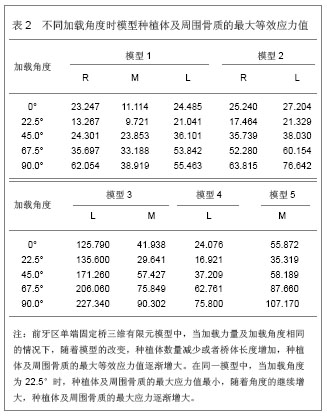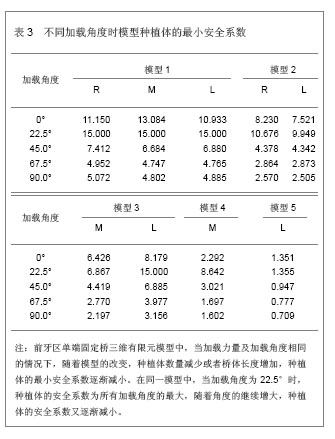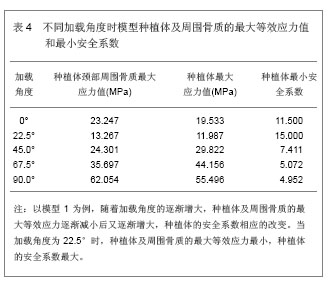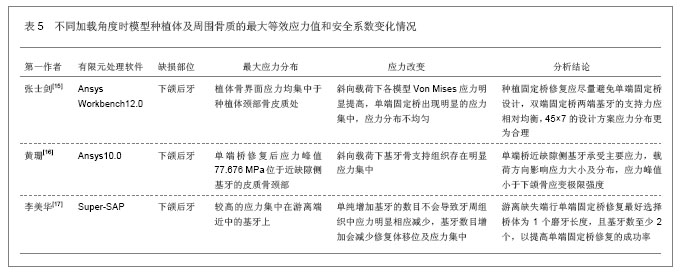2 前牙区单端固定桥三维有限元模型的分析结果
2.1 种植体的最大应力 不同数量的种植体及种植体位于不同位置时的应力分布基本相似,最大应力主要集中于种植体颈部第1螺纹处,种植体应力大的区域其相应的周围骨质应力也增大。
2.2 种植体及骨组织的应力应变
2.2.1 不同加载角度时模型种植体及周围骨质的最大等效应力值 见表2。
 2.2.2 不同加载角度时模型种植体的安全系数 见表3。
2.2.2 不同加载角度时模型种植体的安全系数 见表3。
 2.2.3 不同加载角度时模型种植体及周围骨质的应力应变情况
2.2.3 不同加载角度时模型种植体及周围骨质的应力应变情况 以三维有限元模型1为例,不同加载角度时模型种植体及周围骨质的最大等效应力值和最小安全系数,见表4。

3 单端固定桥的力学特点
牙列缺损常规的修复方法是固定局部义齿和可摘局部义齿,当少数牙体缺失或数个牙间隔缺失时,可以通过固定桥的设计来修复,利用缺牙间隙两端或一端的天然牙或牙根作为基牙,在其上制作固位体,并与人工牙连接成为一个整体,借黏固剂将固位体黏固于基牙上,来修复牙列缺损。
3.1 固定桥的构成 固定桥是由固位体、桥体和连接体3个部分组成。固位体是指在基牙上制作并黏固的全冠、桩冠、部分冠或嵌体等,通过连接体与桥体相连接,使固定桥和基牙形成一个功能整体,并使固定桥获得固位。桥体即人工牙,是固定桥恢复缺失牙形态和功能的部分,借连接体与固位体相连。连接体是固定桥桥体与固位体之间的部分,按连接方式不同分为固定连接体和活动连接体。
3.2 固定桥的特点 ①从力学角度分析。固定桥的力主要由基牙承担,适用于少数牙体缺失或少数间隔牙体缺失,并且要求邻近基牙牙根要有足够的支持力,牙冠固位有良好的固位力,对于侧向移位要有较强的对抗能力。②从稳定角度分析。固定桥的基牙与人工牙通过黏固形成一个功能整体,患者无法摘取,也不需要摘下清洁。基牙的数量由牙周健康状况、缺牙间隙大小和力的大小来决定,各基牙之间能够取得共同就位道。③从结构角度分析。固定桥可以完整的恢复缺失牙面的解剖、颊舌面的突度、颈缘线、邻间隙形态和龈端的形态,使患者感觉与原来牙体相近,无异物感,并与黏膜接触良好,不影响舌部和发音的功能。
3.3 固定桥的分类 ①按桥体结构可以分为双端固定桥、半固定桥、单端固定桥和复合固定桥。双端固定桥又称为完全固定桥,其两端都有固位体,固位体和桥体之间的连接形式为固定连接,可以承受较大的力,两端基牙所承担的力较均匀,双端固定桥是一种最理想的设计形式,也是临床应用最为广泛的设计形式。半固定桥的两端均有不同的连接体,桥体的一端为固定连接体,与固位体固定连接,另一端为活动连接体,多为栓道式结构,栓道位于固位体的近缺隙侧,半固定桥一般适用于一侧基牙倾斜度大或者两侧基牙倾斜方向差异较大,设计双端固定桥很难取得共同就位道时所采用。单端固定桥又称作悬臂固定桥,仅一端有固位体,桥体与固位体之间由固定连接体连接,另一端是完全游离的悬臂,无基牙支持,易以桥体为力臂,基牙为旋转中心产生杠杆作用,使基牙发生扭转和倾斜。复合固定桥至少包含上述2种基本类型,或者全部具备3种的复合组成形式。②按制作材料可以分为金属固定桥、金属烤瓷固定桥、金属树脂固定桥、全瓷固定桥。③按桥体龈端与牙槽嵴黏膜之间的接触关系可以分为桥体接触式和悬空式固定桥。④按加工方式可以分为整体铸造固定桥、分段焊接固定桥、粉浆涂塑烧结固定桥、CAD/CAM固定桥。
3.4 固定桥治疗的适应证 固定桥对基牙、咬合关系、缺牙区的牙槽嵴以及患者年龄都有一定要求。牙冠龈高度应适当,形态正常,牙体硬、软组织健康。牙根要粗壮并有足够的长度,多根牙的牙根有一定的分叉度最好,根周有牙槽骨吸收的基牙,应不超过根长的1/3。牙髓最好是健康的活髓牙,牙髓治疗不彻底或治疗导致余留牙体组织大量减少时,不宜选做基牙。牙周组织要求健康,无进行性炎症,根尖周无病变,牙槽骨及颌骨结构正常,牙槽骨几乎无吸收。基牙位置基本正常,无过度的牙体扭转和倾斜移位。缺牙区的咬合关系要求基本正常,缺牙间隙有适当的龈高度,对颌牙无伸长,有良好的颌间锁结关系,缺隙侧邻牙无倾斜移位。基牙有根尖病变与牙槽嵴吸收的患者不宜应用固定桥修复[11] ,缺牙区的牙槽嵴在拔牙或治疗后3个月完全愈合,形态基本正常,无骨尖、残根、增生及黏膜疾患,牙槽嵴的吸收趋于稳定。患者年龄一般选择青年和壮年阶段,即20-55岁。
3.5 单端固定桥的生物力学分析 固定桥应力分析分为机械力学和生物力学的分析,分析单端固定桥的机械力学,由于单端固定桥仅一端有固位体,另一端为悬臂无基牙支持,是完全游离的或与邻牙维持接触关系[12] 。单端固定桥承受牙合力时,以基牙为旋转中心产生杠杆作用,导致基牙发生扭转和倾斜。固定桥的生物力学分析是研究固位体、桥体和连接体与基牙连接成为一个整体受载后面的应力分布和应变情况。应力的大小和应变的方向与载荷作用的部位、大小有关。表面应变随载荷的加大而增大,离加载点越远,应变越小,同一载荷下,上颌前牙桥的应变大于下颌前牙桥,后牙桥的应变小于前牙桥。加载点位于桥体正中时,桥体表现为弯曲变形,当加载点位于双端固定桥的一端时,桥体产生类似悬臂梁的应力反应。固定桥的拉应力区和压应力区随着多点载荷点的变化而变化。固定桥结构中,桥体的三维结构长度、宽度、高度是影响应变的重要因素,其中长度是最重要的影响因素。固定桥制作材料的刚度影响应变,弹性模量高,应变小。固定桥连接体增厚,可使连接体区剪应力减小。基牙支持力强者,受力后产生的应力和应变均小。
3.5.1 单端固定桥的应力分析 基牙单端固定桥受到垂直载荷时,近缺隙侧基牙承受的是压应力,而且随其倾斜度增加压应力显著增加,远缺隙侧基牙主要接受拉应力。单端固定桥的最大应力集中于基牙的颈部和根尖区,故应采取减轻桥体力的措施。两基牙单端固定桥接受垂直载荷时,瞬间转动中心位于两基牙间的骨间隔内,旋转运动量较单基牙单端固定桥小。单基牙单端固定桥桥体接受载荷时,基牙的倾斜及旋转量大,对基牙的损伤大,尽量少采用这种设计。
3.5.2 基牙和牙周组织的应力应变分布 单端固定桥修复对近缺隙侧基牙和牙周组织条件要求更高[13] 。基牙牙槽骨高度降低时,支持力减小,牙周膜内应力增大。固定桥修复前后相比较,修复后基牙和牙周组织的应力均值相对降低,分布较为均匀。在同一载荷下,基牙牙根数目多、牙根长、根径大,牙周骨吸收少者,则牙根和牙周组织的应力值较低,分布亦较均匀[14] 。固定桥接受垂直载荷时,基牙牙周组织以压应力为主,接受斜向载荷或水平载荷时,基牙牙周组织同时接受拉应力和压应力。基牙对水平、斜向载荷的承受能力较弱。固定桥两端有毗邻牙和接触关系存在时,部分载荷可传递至毗邻牙及支持组织,可略降低基牙牙周组织的应力。固定桥基牙颈周区是应力集中区。龈端接触式桥体及其下牙龈应力分析表明,双端固定桥和半固定桥的载荷几乎全部由基牙牙周组织承担,但桥体下的牙龈组织分担了极少量的载荷,对减轻基牙的负担有一定的帮助。单端固定桥的桥体几乎全部设计为接触式,承担了一定的载荷,载荷的大小、部位、方向;桥体的几何尺寸,材料性能;基牙的支持力大小;桥体游离端是否与邻牙存在接触关系等均影响牙龈组织的应力分布。
3.5.3 应力集中区与结构的关系 固定桥结构的应力集中区分别在连接体处,特别是单端固定桥的连接体处;加载点附近是压应力的集中处;基牙及支持组织的应力集中区分别在基牙颈周骨皮质处;基牙根尖处;牙槽嵴顶处;牙、骨组织内固定桥旋转运动中心所在之处。
3.6 单端固定桥稳定性的影响因素 固定桥的稳定性与固位有密切的关系,固定桥一旦出现翘动现象,很容易破坏黏固剂的封闭和锁结作用,破坏固位体在基牙上的固位,造成固位体的松动脱落。固定桥的稳定性与固定桥受力时产生的杠杆作用有关,不同类型的固定桥在力作用下,对固定桥的稳定性有不同的影响。单端固定桥由于桥体的一端游离无支持,当承受力时最容易产生杠杆作用而破坏固定桥的稳定性,甚至导致基牙的损伤。为减小杠杆作用力,应增加非游离侧的基牙数,通过连接体将其连接起来,牙根数量的增加,即增大了抗力臂以对抗杠杆力。也可以适当减小桥体的近远中径以减小力臂的长度。
3.7 固定桥修复后可能出现的问题及处理
3.7.1 基牙松动 固定桥基牙松动可能与基牙本身有关,基牙条件差或桥体跨度过大,设计的基牙数量不足都有可能造成基牙松动。桥体面恢复过宽或牙尖过陡,恢复的力过大。咬合不良,使基牙遭受创伤。局部或全身健康下降,机体的代偿功能失调,基牙牙周组织的耐受力降低。这些都会影响基牙,使之发生松动现象,对松动的基牙可先采取保守治疗,以减轻负担。若牙周组织损伤严重,且经常引起炎症而产生疼痛,一般应拆除固定桥,治疗患牙后重新修复。
3.7.2 固定桥松动及脱落 固定桥松动及脱落的原因涉及到固定桥的设计、材料、口腔情况以及技术操作等环节。基牙产生继发龋会引起固定桥松动及脱落。基牙牙体预备不当,使其固位体固位力不足也可能引起。桥架变形或就位道略有差异,使其固位体和基牙不密合降低固位体的固位力,试戴时有轻微翘动又未被察觉。金属材料机械强度不足,耐磨性差,固位体穿孔,使得黏固剂溶解或桥架设计不当,引起桥体弯曲变形。黏固剂质量差或黏固操作不当都会引起固定桥松动或脱落。检查并分析其原因,针对原因做相应处理。若基牙产生继发龋,应拆除固定桥,治疗充填患牙后重新设计制作。若系桥基预备体固位力不足,应重新预备牙体。若因金属桥架制作中的缺陷或材料问题,应该重做或更换材料重做。若因黏固剂质量差或者黏固操作有误,需要选用合格材料重新黏固。
3.7.3 固定桥破损 固定桥戴用一段时间后,可能出现金属固位体磨损穿孔、桥体弯曲下沉、连接体脱焊或折断等。金属固位体磨损穿孔可能是由于牙体面预备的空间不足,材料的耐磨性差或易腐蚀。桥体弯曲下沉多因金属桥架材料机械强度差或桥架设计不当,如桥体跨度长,力大,未采用增强桥架强度的措施。连接体脱焊多因焊接技术或焊料有问题。若为整铸桥架,多因连接体的设计不当,如厚度不足或连接处形成峡缝等。目前,多采用金属与硬质复合树脂光固化或热压固化法联合制作固定桥,树脂材料易磨损、变色、脱落,长时间会失去咬合接触,前牙切缘若舌侧无金属背板支持,易折断,树脂易变色和体积的不稳定性,边缘常出现微漏,色素沉着影响美观,金属桥架的固位形不良或表面处理欠佳,而使金属树脂间结合力下降,出现树脂牙面与金属脱离等不良后果。
瓷的最大缺点是脆性较大,易引发瓷折裂或剥脱,产生此现象的原因有几种。金属桥架设计制作不当,使其强度不足而引起桥架变形;桥架表面存在锐角、尖嵴或连接体处呈现 V 形峡缝;金瓷交界处位于力集中部位;承受最大力处无金属基底支持等。瓷层过厚,气孔率增高或瓷层过薄,都会降低瓷的强度。金属桥架表面处理不当,包括打磨、粗化、清洁、除气和预氧化,降低了金瓷结合强度。塑瓷或烧结中的问题,如瓷浆瓷粒缩聚不够,入炉或出炉过快,反复烧结。咬合不平衡,有干扰,导致应力集中。此外,受创伤或咬硬物时力过大都有可能引起瓷裂、瓷剥脱。
固定桥破损后一般都需拆除后重做。对于树脂变色、磨损或烤瓷局部折裂等,在完整摘除固定桥有一定难度时,可在口内用光固化复合树脂直接修补或更换桥体树脂牙面。对于瓷折断而未暴露金属基底,可采用瓷修补的专用光固化复合树脂材料直接在口内修补;若瓷折片小而完整者,可用树脂黏结材料,直接复位黏固;若瓷折脱而暴露金属者,还要在口内粗化金属表面,涂遮色树脂后,用光固化复合树脂修补。用树脂修补瓷缺损的使用寿命有限,一般为两三年。若涉及到咬合功能面时,效果更差。因此,对于瓷裂、瓷剥脱的问题,重在预防其发生。
4 三维有限元分析单端固定桥研究的相关文献
三维有限元分析单端固定桥研究的相关文献,见表5。





.jpg)
.jpg)
.jpg)